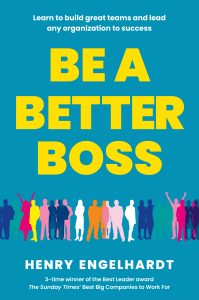By Henry Engelhardt, below, founder and CEO emeritus of Admiral Group plc. His new book, Be a Better Boss: Learn to build great teams and lead any organisation to success, is launched on June 8 by whitefox publishing.
 Finding and selecting senior people in your organisation and/or your team is one of the most important things you can do for the present and future of your organisation/department.
Finding and selecting senior people in your organisation and/or your team is one of the most important things you can do for the present and future of your organisation/department.
Confession: It’s almost a coin flip that you get the right person in just the right spot. It doesn’t matter what searches, psychometric tests, number of interviews, lunches and dinners, graphology reviews, or background checks you do, it’s still kind of 50–50. But I’ve learned plenty over the decades. After all, we started with five people scratching out a business plan in that dismal office, remember? Somehow we got from that handful to 10,000 employees of a highly successful multi-national corporation that is consistently named one of the best companies in the world to work for.
My biggest lesson in building a staff: Recruit talented people, install them at a level lower than you think they should ultimately be at, give yourself time to learn what they’re really like and really good at (and not good at!), and then move the right ones into positions of power and influence.
When it comes to doing it the other way—hiring straight into senior positions—my experience is poor to middling.
This means a different way of recruiting. Many leaders and managers recruit to fill vacancies. This is where I have the poor experience. But if you continually recruit good people and build a surplus of talent, when those vacancies appear you can fill them with known quantities. This is a huge lesson: Fill vacancies with known talent.
But it’s still a challenge to find and recruit those talented people! I’ve found it helps to act like a selective university. Early on, I repurposed a selection of questions from the Graduate Management Admission Test (GMAT)—the standardized entry test taken by hopeful business students (like me in 1987).
The GMAT is academia’s way of taking people with different degrees from different universities, different work experiences, backgrounds, and so on, and finding a way to compare them. My selection (from a practice exam) is one complete set of verbal questions and then most of a quantitative (math) section.
Before giving anyone else the test I did it myself and eliminated the really hard math questions (perhaps you remember my struggles with advanced math). I ended up with 25 math questions and 30 verbal questions. I entered everyone’s scores, verbal and quantitative, in a spreadsheet. As my data sample grew, I had a better tool to measure someone’s score against.
I did the scoring this way: I added up all the correct answers and subtracted all the incorrect answers. I felt this was important; I didn’t want people guessing. If they didn’t have a clue of the answer, I wanted them to leave it blank. This way I could tell risk- takers from conservatives. Risk-takers guessed, conservatives left questions blank. But here’s something interesting: In all my years of giving the test no one asked me how I scored it. If someone had, I would have skipped the test and hired them on the spot!
Unlike the real GMAT, my test had no time limit. But that doesn’t mean time wasn’t a factor. I could learn a lot about a candidate by checking how long it took them to finish, coupled with how many questions they answered and how many they left blank. If someone took a long time and left many questions blank, that told me that they were risk averse. Perfect for some jobs, not great for others. Someone who does it quickly and answers all the questions—while missing some—is a risk-taker. You can only gain this information if you don’t limit their time.
That spreadsheet was just the start. As years passed, we saw a strong correlation between the people who scored well—but not excessively well—and great managers. The maximum score was 55 (25 + 30). The sweet spot for managers who would have people management responsibilities was somewhere between 25 and 45. There can be exceptions, of course, but people who scored outside that range, at either end, were typically less successful on My Three Things that Make a Great Manager (e.g. making great decisions/ being great with people/ being creative and innovative).
The math score was a good proxy for analytical skills. Remember, I had removed all the really hard math questions, allowing only questions I could do! When someone had a low math score, we’d suspect they might not be able to interrogate data and make good decisions based on data. For some jobs, that was fine; for some jobs, the people skills, the verbal skills, were more important. But for jobs where you wanted an analytical mind you really wanted a high quant score.
This sounds very straightforward and reliable, and it was. But we still made mistakes—in one case, by ignoring test data staring us in the face. We paid the price later on.
This was for a very senior position, and strike one was not promoting talent from within. Our goal was to find someone more on the analytical side, although they would also have substantial people management and leadership responsibilities.
Strike two was letting time pressure catch up with us. We liked one guy in particular who scored 32 on the GMAT. Not bad. But within that 32 it was something like 8 on the math and 24 on the verbal. Just the opposite of what we were looking for! Strike three! We hired him anyway and—surprise, surprise—it turned out badly. In particular, he did not seem to understand the ramifications of spending lots of money on advertising that didn’t bring a return! He was very poor with data, so he didn’t bother with it. (Any strikes left?)
As for those verbal skills, they were certainly polished, but it was just a veneer. The first time people met him they almost universally thought he was brilliant. The second time he was OK. By the third meeting everyone began to wonder.
So, three mistakes: 1) hiring someone who we didn’t know to go straight into a senior role; 2) being pressed by time; and 3) ignoring our own data, which was sending a clear message that this was not the profile of the person we wanted.
Think differently?
People sometimes tell me they recruited someone they didn’t really get on with in hopes that this person would bring a different line of thought to the table. Makes me cringe.
My view is that each of us is quite different. We are all diverse, if you will, and if you can add to that by hiring people of different ages, genders, and so on, that’s great. But don’t think you’re getting diversity by hiring people who don’t think like you. All you’re getting is trouble!
Why? Because they don’t think like you! You don’t need everyone to have the same exact thoughts (it’ll never happen) but you do need people who are happy to share in the way you are trying to do things.
And you need to nurture an atmosphere where people are unafraid to speak their mind. I’d wager you get more fresh ideas and intelligent pushback from a group of people who like each other and share a similar outlook on life than you would from a group of people who “think differently” from each other.
Everyone has their own interviewing style. Let me share mine with you. I’m not saying my style is perfect or that no other style will work. But I’ve tested mine over hundreds of interviews and it works for me.
I’d start the interview by holding up the candidate’s CV and saying, ‘Here’s what I know about you. There must be more. Put some meat on the bones.’
And then I’d sit back and see what happened.
I rarely stepped in to say anything while they were going through the CV.
Some people started with their youth and 35 minutes later they had not inhaled.
And they were only up to their university days! They did not get hired. Some people, particularly MBAs, were able to deliver their CVs in 80 seconds. This other extreme was not quite right either. There must be more to you than 80 seconds!
Some of the things people told me when putting meat on the bones were crazy. I learned the insides of companies I never knew existed and cared nothing about. I had one guy say to me, “I really shouldn’t be telling you this but…” and he proceeded to tell me some worthless office gossip concerning a politician. He was right—he never should have told me!
The worst response when I asked them to put meat on the bones was, sadly, one of the most common.
“Where should I start?” they’d say, and I would groan inside.
That showed me that they were unprepared for this interview.
Let me ask you: If you were making a presentation to the board of directors, would you ask the board where you should start? No! You’d start by highlighting the key aspects of what you think is important.
Well, isn’t a job interview one of the more important things you do in a career? You might think that when asked to talk about their CV, an obvious prompt, people would know exactly what to highlight before digging into the pertinent aspects of their history. Amazing how that never happened!
Henry Engelhardt is the founder and CEO emeritus of Admiral Group plc. He has almost 50  years’ working experience, starting with Poochie’s Hot Dogs at age 13. Originally American, Henry settled in Wales several decades ago and he was awarded a CBE in 2008. Admiral, headquartered in Cardiff – the only FTSE 100 company in Wales – has been consistently listed in the Sunday Times Best Companies to Work in the last 20 years. Henry’s new book, Be a Better Boss: Learn to build great teams and lead any organisation to success, is launched on June 8 by whitefox publishing.
years’ working experience, starting with Poochie’s Hot Dogs at age 13. Originally American, Henry settled in Wales several decades ago and he was awarded a CBE in 2008. Admiral, headquartered in Cardiff – the only FTSE 100 company in Wales – has been consistently listed in the Sunday Times Best Companies to Work in the last 20 years. Henry’s new book, Be a Better Boss: Learn to build great teams and lead any organisation to success, is launched on June 8 by whitefox publishing.


